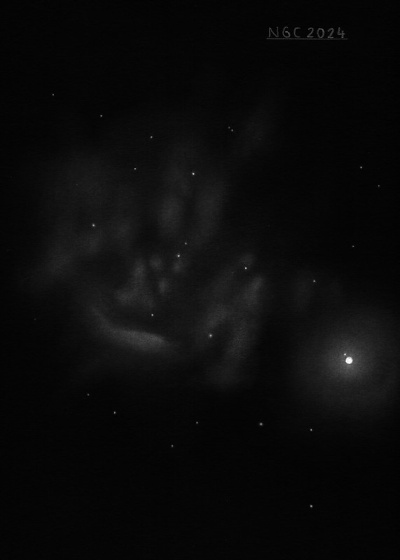
William Herschel discovered NGC 2024 = H V-28 on 1 Jan 1786 (sweep 506) and recorded "a wonderful milky nebulosity, divided into 3 or 4 large patches including a dark space, the whole cannot take up less than half a degree; but I suppose it to be much more extensive." A month later (sweep 518) he noted "Wonderful black space inlcuded in nebulosities."
The following information is from Wolfgang Steinicke's book "Observing Cataloguing Nebulae and Star Clusters. NGC 2024 was independently found by Brorsen in 1850 with a small refractor at Senftenberg Observatory and announced in AN that "I have found a very faint, very extended, pretty irregular nebula, located about 15 minutes east of Zeta Orionis, which is listed neither in the catalogue of the younger Herschel nor in Messier's." In 1856 Marth noted that Brorsen's object was William Herschel's H. V-28. This was another case where the observer only checked the Slough catalogue and didn't refer to WH's catalogues, which only had relative offsets and not absolute positions.
Heinrich d'Arrest sketched the nebula in 4 sections. The brightest section (labeled A) is just west of the main dust lane. This object was observed 13 times at Birr Castle from 1873-1878 by Lawrence Parsons (with the 36-inch), Ralph Copeland and Dreyer, and stars "in an about the neb" were sketched and accurately measured.
Garrett Serviss (Pleasures of the Telescope, 1901) wrote "Just to the left of Zeta, and in the same field of view with a very low power, is a remarkable nebula bearing the catalogue number GC 1227. We must use our five-inch on this with a low power, but with Zeta out of the field in order to avoid its glare. The nebula is exceedingly faint, and we can be satisfied if we see it simply as a hazy spot, although with much larger telescopes it has appeared at least half a degree broad. Tempel saw several centers of condensation in it, and traced three or four broad nebulous streams, one of which decidedly suggested spiral motion."
200/250mm - 8" fairly easy in very dark skies, the strip along the east side is longer with a possible gap at the base of "U" in the southwest corner. The center is definitely darker than the background sky.
8" (10/4/80): fairly bright, large. Consists of two parallel strips separated by a dark lane. Appears possibly broken (gap) at the base of "U". Best view with a UHC filter.
400/500mm - 17.5" (2/8/86): bright, very large. Consists of two main parallel sections elongated SSW-NNE separated by prominent detailed dark lanes. Excellent structure with ragged edges, gaps, streaks, rifts and various brightness levels. The eastern strip has one or two indentations or a scalloped inner edge. The inner edge of the connecting strip has a sharply defined edge and the gap at the base connecting the brighter western section is obvious. Zeta Orionis lies 15' NE detracts and the best view is unfiltered.
Notes by Steve Gottlieb